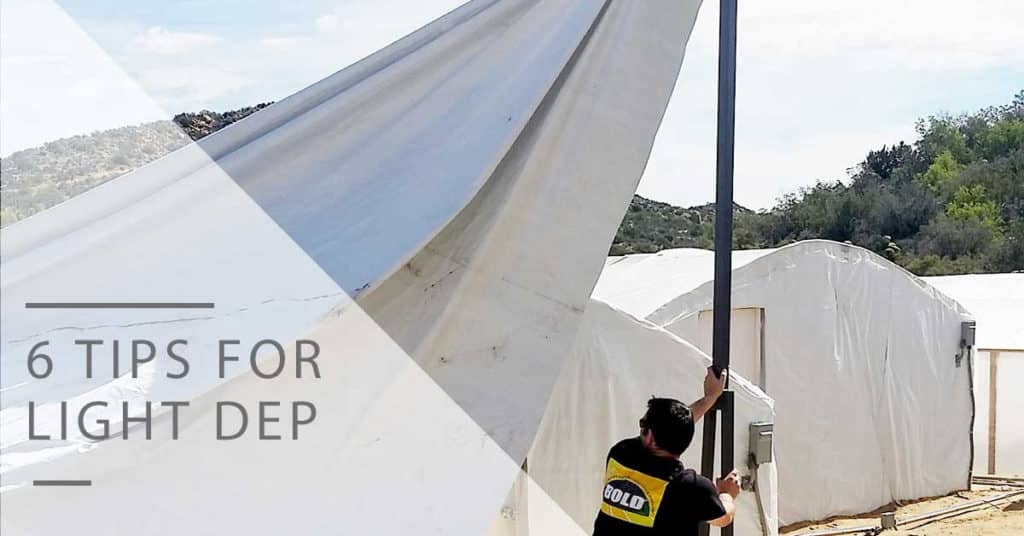Cannabis Light Deprivation Tips from a Grower

In 2018, Tevan Riedel, president of Americover, Inc., shared six great tips for growers interested in using light deprivation for their crops. We’re looking back at some of the best cannabis light deprivation, or light dep, tips and some new updates.
Light deprivation is a technique that employs reducing the amount of light plants receive during the growth process. In doing so, the final flowering stage begins before it would naturally: autumn. First developed in 1980s California, the practice gained expansive use in the early 2000s. Some of the results typically seen in light deprivation cannabis are larger, improved buds quicker due to extended flowering periods. Other reported benefits of cannabis light deprivation are increased number of harvests per season, better control over unpredictable weather and the final flowering timing, as well as a lowered carbon footprint.
While outdoor cannabis light deprivation is possible (more on this later), many growers practice light deprivation weed methods in a greenhouse, with ventilation equipment and lightproof material for plant covering. While processes may vary, the most important aspect of light dep is plants are in complete darkness for a minimum of 12 hours per day. Small operations also cover plants individually or move them into a dark room.
It is important to note light deprivation weed vs indoor product grown the age-old way will have some differences. Foremost, light depping requires extra work and expense. Plant qualities such as taste, appearance, shape, color and secondary metabolite production can all be affected. Additionally, light deprivation does not work on auto-flowering cannabis plants. Because these plants transition automatically from the vegetative phase to the flowering stage based on age, the total light they are exposed to will not make a difference in yield.
If the light dep growing method is intriguing, read below to gleam optimizing tips for light dep cannabis at its best.
1. Choose the right strain
As mentioned above, auto-flowering plants are not affected by light depping. Therefore, when choosing strains to cultivate, ensure “non-auto flowering” is added to the list of selection criteria. Understand the expected length of the flowering and vegetative cycles, as strains with rapid and vigorous vegetative growth are perfect to light deprivation.
2. Stick to your schedule
A set light dep schedule allows growers to benefit from a definite harvest date, and it’s best for plant health. Many growers find automatic timers to be the best way to keep up with a precise schedule.
3. Ventilation is key
Maintaining adequate ventilation is crucial when using the light deprivation technique. Without proper air circulation, the temperature and humidity may stress out the plants or cause bud rot.
Bonus tip: Utilize technology
Technology in the light deprivation world has had some helpful advancements. These include specifically designed circulation systems, hybrid lighting systems, automated blackout systems and spectrally selective films, which allow beneficial sunlight while blocking unwanted wavelengths that trigger flowering.
4. Avoid light leaks at all costs
Light deprivation, as a practice, does not permit much room for error. A pinhole of light can cause plants to herm and go to seed, ruining the whole crop. A rigid schedule of darkness should not be neglected, even at night. Commonly used ways to block out light are blackout curtains, or large heavy-duty tarps manually rolled out during nighttime hours, and inflatables that are double-walled, air-filled structures used to create a blackout effect when inflated.
“You have to make sure there’s no light, or you don’t get the results you need,” said Dr. Jordan Lewis, CEO of Fotmer Life Sciences, a cannabis cultivation and extraction company based in Montevideo, Uruguay.
5. Trim your plants
During the vegetative phase, trim the plant to remove large, light-blocking leaves to allow more light to the flowering sites. By removing this extra growth, plants can be more productive by redirecting energy to the buds. Do not over-trim, though.
6. Get help to cover/uncover
A standard 12-hour light deprivation schedule means covering and uncovering plants up to four times per day. Before beginning a light dep cultivation, make a contingency plan for sticking to the schedule. For some, that can mean investing in wholly automated systems or one-person assisted systems like BOLD EZarm.
If outside growing is your preference and outdoor cannabis light deprivation is something you want to try, consider these tips for light dep cannabis in the open air:
- Temperature and light leaks are the main focus of successful outdoor light dep.
- Sun overhead can translate to overheating, so monitor temperatures constantly.
- Regularly test for light leaks. If a book can be read inside during the darkness phase, there is too much light.
Learn to Grow at CannaCon
CannaCon is the nation’s leading business-to-business cannabis conference and the best spot for updated information about the industry. Learn cultivation techniques from industry experts and more. Follow us on social media and attend a CannaCon cannabis conference in 2025!
This article was originally posted on Jan. 20, 2018 by Tevan Riedel and updated on Jan. 18, 2025 by CannaCon.
